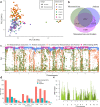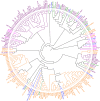Population structure, genetic diversity and genomic selection signatures among a Brazilian common bean germplasm
- PMID: 33536468
- PMCID: PMC7859210
- DOI: 10.1038/s41598-021-82437-4
Population structure, genetic diversity and genomic selection signatures among a Brazilian common bean germplasm
Abstract
Brazil is the world's largest producer of common bean. Knowledge of the genetic diversity and relatedness of accessions adapted to Brazilian conditions is of great importance for the conservation of germplasm and for directing breeding programs aimed at the development of new cultivars. In this context, the objective of this study was to analyze the genetic diversity, population structure, and linkage disequilibrium (LD) of a diversity panel consisting of 219 common bean accessions, most of which belonging to the Mesoamerican gene pool. Genotyping by sequencing (GBS) of these accessions allowed the identification of 49,817 SNPs with minor allele frequency > 0.05. Of these, 17,149 and 12,876 were exclusive to the Mesoamerican and Andean pools, respectively, and 11,805 SNPs could differentiate the two gene pools. Further the separation according to the gene pool, bayesian analysis of the population structure showed a subdivision of the Mesoamerican accessions based on the origin and color of the seed tegument. LD analysis revealed the occurrence of long linkage blocks and low LD decay with physical distance between SNPs (LD half decay in 249 kb, corrected for population structure and relatedness). The GBS technique could effectively characterize the Brazilian common bean germplasms, and the diversity panel used in this study may be of great use in future genome-wide association studies.
Conflict of interest statement
The authors declare no competing interests.
Figures






Similar articles
-
In-depth genome characterization of a Brazilian common bean core collection using DArTseq high-density SNP genotyping.BMC Genomics. 2017 May 30;18(1):423. doi: 10.1186/s12864-017-3805-4. BMC Genomics. 2017. PMID: 28558696 Free PMC article.
-
Genetic Diversity, Population Structure, and Andean Introgression in Brazilian Common Bean Cultivars after Half a Century of Genetic Breeding.Genes (Basel). 2020 Oct 30;11(11):1298. doi: 10.3390/genes11111298. Genes (Basel). 2020. PMID: 33143347 Free PMC article.
-
Genome-wide diversity analysis to infer population structure and linkage disequilibrium among Colombian coconut germplasm.Sci Rep. 2022 Feb 22;12(1):2958. doi: 10.1038/s41598-022-07013-w. Sci Rep. 2022. PMID: 35194112 Free PMC article.
-
SNP discovery in common bean by restriction-associated DNA (RAD) sequencing for genetic diversity and population structure analysis.Mol Genet Genomics. 2016 Jun;291(3):1277-91. doi: 10.1007/s00438-016-1182-3. Epub 2016 Mar 1. Mol Genet Genomics. 2016. PMID: 26932372
-
Evolution of SSR diversity from wild types to U.S. advanced cultivars in the Andean and Mesoamerican domestications of common bean (Phaseolus vulgaris).PLoS One. 2019 Jan 31;14(1):e0211342. doi: 10.1371/journal.pone.0211342. eCollection 2019. PLoS One. 2019. PMID: 30703134 Free PMC article.
Cited by
-
Genetic diversity of common bean (Phaseolus vulgaris L.) ecotypes from Pakistan using Simple Sequence Repeats.Saudi J Biol Sci. 2022 Jun;29(6):103300. doi: 10.1016/j.sjbs.2022.103300. Epub 2022 Apr 22. Saudi J Biol Sci. 2022. PMID: 35540177 Free PMC article.
-
Population structure analysis to explore genetic diversity and geographical distribution characteristics of cultivated-type tea plant in Guizhou Plateau.BMC Plant Biol. 2022 Jan 27;22(1):55. doi: 10.1186/s12870-022-03438-7. BMC Plant Biol. 2022. PMID: 35086484 Free PMC article.
-
Analysis of population structure and genetic diversity of Camellia tachangensis in Guizhou based on SNP markers.Mol Biol Rep. 2024 Jun 1;51(1):715. doi: 10.1007/s11033-024-09632-0. Mol Biol Rep. 2024. PMID: 38824248 Free PMC article.
-
Determining Genetic Diversity and Population Structure of Common Bean (Phaseolus vulgaris L.) Landraces from Türkiye Using SSR Markers.Genes (Basel). 2022 Aug 8;13(8):1410. doi: 10.3390/genes13081410. Genes (Basel). 2022. PMID: 36011321 Free PMC article.
-
Whole-genome resequencing of common bean elite breeding lines.Sci Rep. 2023 Aug 5;13(1):12721. doi: 10.1038/s41598-023-39399-6. Sci Rep. 2023. PMID: 37543642 Free PMC article.
References
-
- Broughton WJ, et al. Beans (Phaseolus spp.)—model food legumes. Plant Soil. 2003;252:55–128. doi: 10.1023/A:1024146710611. - DOI
-
- FAO, F. and A. O. FAOSTAT: FAO Statistical Databases. http://www.fao.org/faostat/ (2020).
Publication types
MeSH terms
Substances
LinkOut - more resources
Full Text Sources
Other Literature Sources
Research Materials

